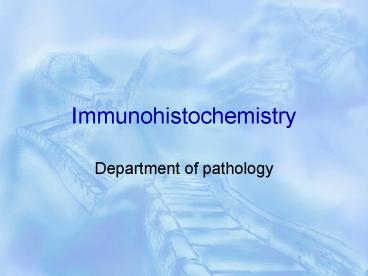Immunohistochemistry PowerPoint PPT Presentation
1 / 25
Title: Immunohistochemistry
1
Immunohistochemistry
- Department of pathology
2
Introduction
- Immunohistochemistry (IHC) combines histological,
immunological and biochemical techniques for the
identification of specific tissue components by
means of a specific antigen/antibody reaction
tagged with a visible label. IHC makes it
possible to visualize the distribution and
localization of specific cellular components
within a cell or tissue.
3
History
- The principle has existed since the 1930s.
- Started in 1941 when Coons identified pneumococci
using a direct fluorescent method. - Indirect method
- Addition of horseradish peroxidase
- Peroxidase anti-peroxidase technique in 1979
- Use of Avidin Biotin complex in early 1980s
4
Principle
- The principle of immunohistochemistry is the
localization of antigens in tissue sections by
the use of labeled antibodies as specific
reagents through antigen-antibody interactions
that are visualized by a marker such as
fluorescent dye, enzyme, radioactive element or
colloidal gold.
5
Method
- Direct Method
- Indirect Method
- PAP /APAAP Method
- ABC Method
- SP Method
6
Direct Method
Labeled Antibody
Tissue Antigen
7
Two-Step Indirect Method
Secondary Antibody
Primary Antibody
Tissue Antigen
8
PAP Method (peroxidase anti-peroxidase method)
9
ABC Method (avidin-biotin complex method )
10
SP Method(streptavidin peroxidase conjugated
method)
11
Applications
- Cancer diagnostics
- differential diagnosis
- Treatment of cancer
- Research
12
General Immunohistochemistry Protocol
13
Part 1
Tissue preparation
- 1.Fixation
- formalin fixation and paraffin embedding
- 2.Sectioning
- 3. Whole Mount Preparation
14
Part 2
pretreatment
- 1. Antigen retrieval
- Proteolytic enzyme method and Heat-induced
method - 2. Inhibition of endogenous tissue components
- 3 H2O2, 0.01 avidin
- 3. Blocking of nonspecific sites
- 10 normal serum
15
Part 3
staining
- Make a selection based on the type of specimen,
the primary antibody, the degree - of sensitivity and the processing time
required as well as the cost of the reagents.
16
SP Method(streptavidin peroxidase conjugated
method)
17
Controls
- Positive Control
- It is to test for a protocol or procedure
used. - It will be ideal to use the tissue of known
positive as a control. - Negative Control
- It is to test for the specificity of the
antibody involved.
18
Example
- 1. Prepare and fix tissue
- 2. Antigen retrieval
- 3.Suppress endogenous peroxidase activity
- 4. Block nonspecific sites in the tissues
- 5. Incubate the tissues with the primary antibody
- 6. Incubate the tissues with the secondary
antibody - 7. Incubate the tissues with SP
- 8.Add DAB and incubate until desired staining is
achieved
19
Troubleshooting
- 1. Weak or No Staining
- 2. Over-staining
- 3. High Background
20
Weak or No Staining
21
Weak or No Staining
22
Over-staining
23
High Background
24
Thank you !
25
- Immunohistochemistry techniques have been used
since the 1940s, when AH Coons and colleagues
published their landmark paper describing the
identification of tissue antigens using a direct
fluorescence protocol (Coons AH, Creech HJ, Jones
RN (1941) Immunological properties of an antibody
containing a fluorescent group. Proc Soc Exp Biol
Med 47200202).

